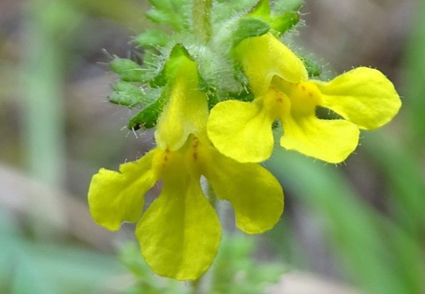Abstract
A new species of the genus Phtheirospermum (Orobanchaceae) is described and illustrated from Mizoram, an Indo–Burma biodiversity hotspot in India. Detailed description, digital photographs, comparison of morphological characters with closely allied species is provided here for easy identification.
References
- Bachman, S., Moat, J., Hill, A.W., Torre, J. de la & Scott, B. (2011) Supporting Red List Threat Assessments with GeoCAT: Geospatial Conservation Assessment Tool (Version BETA). e-Infrastructures for data publishing in biodiversity Science. Zookeys 150: 117–126.
- Bonati, G. (1921) New species of the genera Phtheirospermum and Pedicularis. Notes from the Royal Botanic Garden, Edinburgh 13: 103–141.
- Don, D. (1825) Prodromus florae Nepalensis. J. Gale, London, 256 pp.
- Dong, L.N., Wang, H., Wortley, A.H., Lu, L. & Li, D.Z. (2013) Phylogenetic relationships in the Pterygiella complex (Orobanchaceae) inferred from molecular and morphological evidence. Botanical Journal of the Linnean Society 171 (3): 491–507. https://doi.org/10.1111/j.1095-8339.2012.01326.x
- Dong, L.N., Wang, H., Wortley, A.H., Li, D.Z. & Lu, L. (2015) Fruit and seed morphology in some representative genera of tribe Rhinantheae sensu lato (Orobanchaceae) and related taxa. Plant Systematics and Evolution 301: 479–500. https://doi.org/10.1007/s00606-014-1087-8
- FSI (2021) India state of forest report. Forest Survey of India, Dehradun. [https://fsi.nic.in/forest-report-2021-details]
- Hooker, J.D. (1884) Pedicularis. In: Hooker, J.D. (Ed.) Flora of British India 4. L. Reeve and Co., London, pp. 306–317.
- Hooker, W.J. (1872) Icones Plantarum, or Figures, with Brief Descriptive Characters and Remarks, of New or Rare Plants, Selected from the Author's Herbarium, Vol. 12. Longman, London.
- Hughes, C.E. & Atchison, G.W. (2015) The ubiquity of alpine plant radiations: from the Andes to the Hengduan Mountains. New Phytologist 207 (2): 275–282. https://doi.org/10.1111/nph.13230
- IUCN Standards and Petitions Committee (2022) Guidelines for using the IUCN Red List Categories and Criteria. Version 15. Prepared by the Standards and Petitions Committee (accessed 12 February 2023)
- Jain, S.K. & Rao, R.R. (1977) A Hand Book of Field and Herbarium Methods. Today and Tomorrow’s Printers and Publishers, New Delhi.
- Mabberley, D.J. (2017) Mabberley's plant-book: a portable dictionary of plants, their classification and uses. Ed. 4. Cambridge university press. https://doi.org/10.1017/9781316335581
- Prain, D. (1889) Noviciae Indicae. I. Some additional species of Pedicularis. The journal of the Asiatic Society of Bengal 58: 255–278.
- Prain, D. (1890) The species of Pedicularis of the Indian empire and its frontiers. Annals of the Royal Botanic Garden (Calcutta) 3: 1–196.
- Prain, D. (1903) Some additional Scrophulariaceae. The journal of the Asiatic Society of Bengal 72 (2): 11–23.
- Sengupta, R. & Dash, S.S. (2020) Invasion status of three non–native species from family Asteraceae in Mizoram. Nelumbo 62 (1): 27–39. [https://nelumbo-bsi.org/index.php/nlmbo/article/view/153742] https://doi.org/10.20324/nelumbo/v62/2020/153742
- Singh, N.P., Singh, K.P. & Singh, D.K. (2002) Flora of Mizoram, Vol. 1. Botanical Survey of India, Kolkata, 50 pp.
- Singh, R.K., Kholia, B.S. & Sudhakar, J.V. (2016) Pedicularis artiae, a new species of Orobanchaceae from Sikkim Himalaya, India. Kew Bulletin 71 (36): 1–5. https://doi.org/10.1007/s12225-016-9649-2
- Tao, D.D. (1996) A taxonomic study on the genus Phtheirospermum (Scrophulariaceae) Acta Botanica Yunnanica 18: 301–307. [https://journal.kib.ac.cn/EN/abstract/abstract30951.shtml]
- Wu, Z. & Raven, P.H. (1998) Flora of China. Scrophulariaceae through Gesneriaceae, Vol. 18. Science Press, Beijing, and Missouri Botanical Garden Press, St. Louis, 450 pp.
- Yu, W.B., Randle, C.P., Lu, L., Wang, H., Yang, J.B., DePamphilis, C.W. & Li, D.Z. (2018) The hemiparasitic plant Phtheirospermum (Orobanchaceae) is polyphyletic and contains cryptic species in the Hengduan Mountains of southwest China. Frontiers in Plant Science 9: 142. https://doi.org/10.3389/fpls.2018.00142


